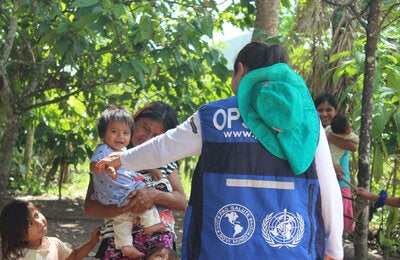
Over 26 million people in the Americas are visually impaired, and over 3 million are blind. Nearly 80% of these cases are preventable or curable
Washington, D.C., 2 October 2014 (PAHO/WHO) — More than 26 million people in the Americas are visually impaired (blind or unable to see clearly), yet an estimated 80% of these cases are preventable or curable. To address the problem, health officials from the region's countries today approved a plan of action to fight preventable blindness and visual impairment.
The plan was approved during a meeting of the 53rd Directing Council of the Pan American Health Organization (PAHO), which brings together ministers of health from throughout the Americas for five days of discussions on priority health issues and actions to address them.
Over 3 million people in the Americas are blind, most of them over the age of 50. Cataract and glaucoma are responsible for 75% of cases of blindness, but other causes include diabetic retinopathy, glaucoma, age-related macular degeneration, and refractive errors.
The plan of action includes measures specifically aimed at keeping premature babies, schoolchildren, and people over the age of 50 from losing their sight. It calls for better neonatal care to prevent retinopathy of prematurity, which can cause blindness in preterm babies and has reached epidemic proportions in lower-income countries. The plan also targets school?aged children, an estimated 7% of whom may need vision correction in Latin America.
"In the past decade, we have managed to increase coverage and access to eye health services to prevent and correct visual impairment in the Americas," said Juan Carlos Silva, PAHO/WHO Regional Advisor on Visual Health. "But we must make even greater efforts to control blindness and visual impairment from cataracts and other causes and improve the quality of surgical services."
Surveys in nearly half the countries of the Americas indicate that there are enough ophthalmologists to reduce the number of people who either partially or totally lose their sight. However, these professionals are unevenly distributed.
To reduce preventable visual impairment and guarantee access to rehabilitation services, the plan of action proposes that countries:
- generate and use data on eye health in the population for decision-making and evidence-based policy-making
- develop, update, implement, and monitor national and subnational policies and plans
- provide accessible, affordable, quality eye health services for the entire population
- create and maintain a trained, productive workforce that is equitably distributed
- strengthen the organizational capacity of public eye health services to provide efficient, affordable, high-quality eye care services
- strengthen the primary eye care system's capacity to detect and refer people over 50 with visual impairments
- set up a surgical quality and productivity system in cataract surgery services
- increase cataract surgery coverage for all segments of the population and adherence to quality standards
- develop programs to improve the quality of neonatal care and the prevention, detection, and treatment of retinopathy of prematurity
- detect and treat uncorrected refractive error in schoolchildren and adolescents through effective screening and management programs.
The Plan of Action for the Prevention of Blindness and Visual Impairment 2014-2019 is an update of a plan approved by the PAHO Directing Council in 2009. The new plan includes the commitments established in the WHO global action plan 2014-2019 and the PAHO Strategic Plan 2014-2019. It was prepared with input from the ministries of health of the Americas, groups of experts, collaborating centers, and international partners.
Since 2009, the PAHO eye health program has generated and used epidemiological evidence on visual impairment, prepared documentation on good practices, and supported national policy-making, plans, and programs and the strengthening of eye health services and systems, helping to improve universal access to eye health.
Facts about visual impairment in the Americas
- In 2010, 26 million people in the Americas had some type of visual impairment
- More than 3 million were blind, and most of these were over age 50
- Nearly 80% of these cases of blindness could have been prevented
- Diabetic retinopathy accounts for up to 16% of blindness in the Americas
- 30% of people with diabetes develop diabetic retinopathy, and 1% of them suffer from proliferative diabetic retinopathy with a very high risk of blindness
- In Latin America, the prevalence of glaucoma ranges from 1% to 3.4% in people over 50 and represents 15%-20% of the causes of blindness in countries with larger Afro?descendant populations
- Age-related macular degeneration causes 7% of blindness and 3% of visual impairments worldwide and is a major cause of blindness in Southern Cone countries
- An estimated 7% of schoolchildren in Latin America may be in need of vision correction



